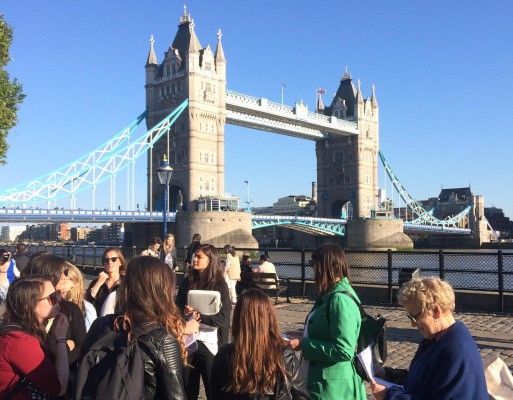Virginia Woolf Walk
Louise Tucker, in green, with the “Writing for Magazines” class (PHOTO COURTESY OF LEIGHTON SCHNEIDER)
July 27, 2015
Our tour guide for the day was Louise Tucker, a former Virginia Woolf scholar, who took us through some of the locations Woolf describes in her collection of essays, “The London Scene.” This series of writings appeared in the magazine “Good Housekeeping” from 1931 and 1932 and documented her experiences in the city of London in the early 1900s. Woolf witnessed the construction of famous landmarks and saw London change and expand into the city we all know today.
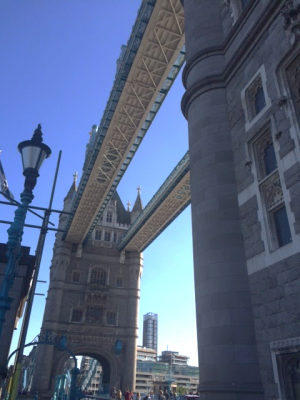
We met Louise on the Tower Bridge, where she grabbed our attention by informing us that “Virginia Woolf would have been very aware of this bridge being built.” Though the architecture of the bridge looks like London had gone backwards the construction of the suspension bridge across the Thames showed how London was starting to modernize.
Speaking over the wind and the noise, Louise quoted Woolf’s “The Docks of London.” “As we come closer to the Tower Bridge, the authority of the city begins to assert itself. The buildings thicken and heap themselves higher… One hears the roar and the resonance of London itself.”
Before we exited the bridge to explore the rest of London, Louise told the group to look to the west and then to the east. While the east has a bustling skyline filled with unique towers with nicknames such as “The Cheese Grater,” the west paled in comparison. “This bridge marks one of the starting points of square mile,” Parker mentions, “where the original City of London starts.”
While London is ever expanding, the term, “The City,” refers to the original square mile radius. The area now called “West London,” where Woolf lived in Richmond, was not even a part of London in her time. When looking west off of Tower Bridge, you can understand how she must have felt when cruising down the River Thames as the countryside transitioned into the bustling city.
We continued our journey east, up the hills to the main road, as we all complained about how hot it had become. “Every day you have to bring both your sunglasses and an umbrella,” Louise quipped.
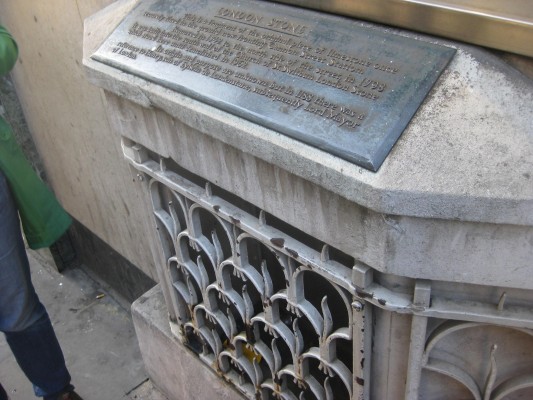
As we walked on, Tucker mentioned that the streets were named for their uses. For example, the street called ‘Eastcheap,’ was the former location of the main meat market of London, with “cheap” being the archaic work for “market.” Another street of significance was ‘Pudding Lane,’ which Louise pointed out as the starting point of The Great Fire of London. With additional research, I found out that it is named after the “puddings” (a medieval word for entrails and organs) which would fall from the carts coming down the lane from the butchers in ‘Eastcheap’ as they left the market.
As we passed by the historic street, I noticed a modern sushi restaurant below the ‘Pudding Lane’ street sign. A town known for its vast marketplaces was now occupied by modern chain restaurants such as McDonald’s and Starbucks. Heck, as we walked down the historic cobblestone streets, some of us were even playing a game called “Count the Pret a Mangers.” Surely this was not what Virginia Woolf saw in her day. Did her modernization include a Victorian Cafe Nero every three blocks?
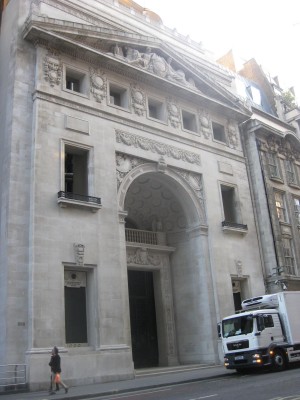
Louise then took us to the London Stone, which marks the center point of The City of London. As everyone took their pictures, Louise pointed out the tube stop farther ahead, Cannon Street, was under construction. The city was in the process of building the ‘Crossrail,’ a new railway line running east to west. “The Tube was being built when Woolf was a kid,” Tucker mentioned. “See, since people used horse and carriage to get around there was too much horse poo on the streets. It was the nice, clean underground.” She remarked how the city always seems to be building something new. “Ours is just like her day,” she said, “constant construction.”
After passing through Leadenhall Market, we make a right onto Leadenhall Street and Louise stopped us in front of this beautiful constructed door that looked like it came from the same time period as the Tower Bridge. “This is the door to the Lloyd’s Building,” Tucker told us.
It looks like something out of Charlie and The Chocolate Factory,” one of the students said. The Lloyd’s Building is the home of the insurance institute of Lloyd’s of London. The structure has been giving the nickname the “Inside Out Building” since the lifts are on the outside of the building to open up the space inside. The original 1928 building’s entrance was preserved and forms a rather incongruous attachment to the structure rebuilt in 1986. This building encompasses the true feel of London–the constant modernization that is still rich with historical architecture.
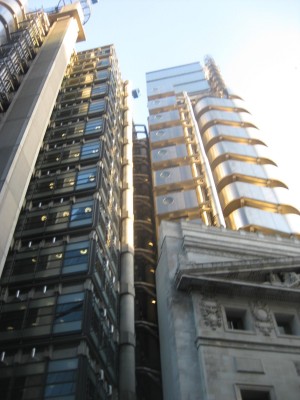
In her writings, Woolf touches upon about how St. Paul’s “looms” over the city’s skyline, and, to be frank, it still does. Even with buildings climbing higher and higher into the sky as the years go on, the 18th century structure still dominates the city.
We ended our tour in the heart of east London, right between the iconic Old Spitalfields Market and Brick Lane. “Virginia would have never gone here. This place was considered dodgy during her time,” Tucker said as she described the streets adjacent to the Ten Bells Pub, infamous for their association with two victims of Jack the Ripper. “Now it’s the place to be. These houses were worth nothing in her time and now they are worth millions.”
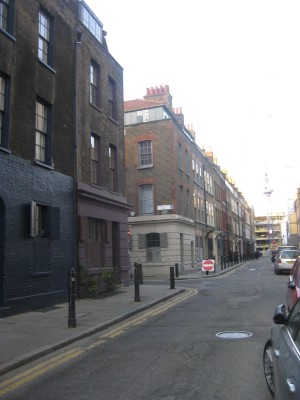
Louise then paraphrases a quote from Woolf’s “Great Men’s Houses” “You can’t really go into London until you go into someone’s house ” she says as she turns to look at the homes across the street. “So, since we can’t really go into this person’s house, look at them, instead.”
London is seemingly always evolving itself to adapt with the times. Sure, we might not have experienced the construction of the majestic Tower Bridge or the beginning of The Tube, but we have seen the social structure shift right before our eyes as modern skyscrapers and vintage clothing stores take over the city. Maybe we should write essays of our own about our London, just like Woolf.

